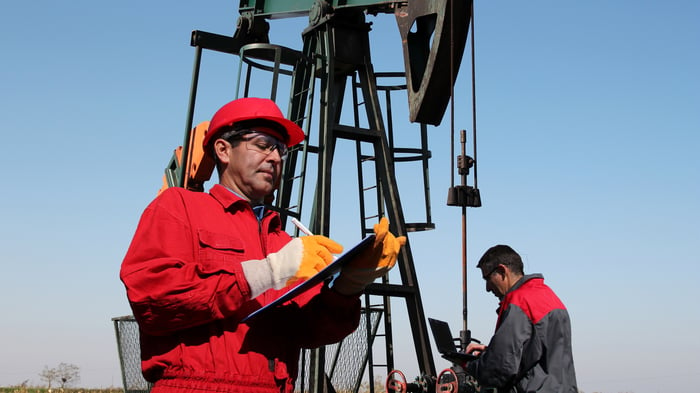ExxonMobil Corporation (XOM 0.24%) is going against the grain with plans to materially increase its capital spending over the next five years. Peers like Chevron Corporation, which recently announced that 2018 would be its fourth consecutive year of falling capital spending, are generally going in the opposite direction.
Here's why Exxon is spending more, and a look at whether or not it can afford its ambitious spending and its dividend at the same time.
The problem with Exxon's oil wells
One of the biggest issues facing Exxon today is falling production in its upstream business -- it dropped 1% in 2016 and 1.7% in 2017. Those are small numbers, to be sure, but they are going the wrong direction. If it doesn't stabilize or increase its production, its business is effectively shrinking over time. And with oil prices heading higher, it is basically missing out on an opportunity to make larger profits.

Image source: Getty Images
To that end, Exxon has been looking for projects in which to invest so it can start growing its production again. It has successfully lined up a host of big oil and natural gas deals that should provide it with material growth opportunities, including plans to invest in onshore U.S. oil and gas, deepwater oil in Guyana and Brazil, and gas production in Mozambique. And it has plans to expand its downstream operations in refining and chemicals on top of that.
All of this will cost money. In 2018 Exxon's capital spending plan will require $24 billion, up roughly $1 billion from 2017. Spending in 2019 jumps to $28 billion, and for the three years after that will be as much as $30 billion. That's a lot of money out the door, especially for a company that paid out roughly $13 billion to investors in 2017 in the form of dividends. Can Exxon afford to support the dividend and its capital spending plans?
Some breathing room
In 2017 the oil giant's dividends and growth spending were covered by cash flow, but that required a little help from asset sales. With higher prices, however, 2018 has gotten off to a stronger start. Capital spending and dividends cost roughly $8.2 billion in the first quarter, with cash flow of about $10 billion. That $10 billion includes $1.4 billion of asset sales, which can't be counted on every quarter but remain a key part of Exxon's plan as it prunes assets to better focus its business -- and raise much needed cash.

Exxon's first quarter results summary. Image source: ExxonMobil Corporation
Oil prices have continued to rise this year, which is clearly making it easier for Exxon to cover its spending plans. So long as oil prices remain steady or move higher, Exxon has a cushion. Higher oil prices should also make it easier for the company to get top dollar for any divestments it makes.
That said, there's another place for Exxon to find cash: its balance sheet. The company's long-term debt rose dramatically during the oil downturn that started in mid-2014, going from $6.5 billion at the end of 2013 to a peak of $27.7 billion at the end of 2016. It dropped to roughly $23 in 2017 as the company used improved oil prices to pare its debt load.
However, even at the peak in 2016, long-term debt only accounted for around 15% of the company's capital structure. That's relatively high for Exxon, but not high relative to the broader integrated oil peer group. Take a look at the graph below --Exxon's debt to equity ratio is way down at the bottom, and by a wide margin compared to some of its European peers. In other words, Exxon can always rely on its balance sheet to carry it through on the spending front.
XOM Financial Debt to Equity (Quarterly) data by YCharts
However, don't forget about the impact of the company's spending. Although you can't actually predict how an oil project is going to play out in the real world, the drawing board plans look very promising. For example, Exxon's reserves increased 6% in 2017 based on its exploration efforts. Assuming it can turn that into additional oil production, higher sales volumes will also be a part of the mix. And that will provide even more cushion for the dividend.
Exxon's got you covered
Clearly, Exxon's spending plans are going to cost a lot money. However, if oil prices remain strong it looks like Exxon can cover its dividend and capital spending needs. That may require additional asset sales along the way, but pruning the portfolio is not a bad thing or unusual. And if there's a shortfall in a given year, the integrated oil giant still has a very strong balance sheet to fall back on.
Meanwhile, if you assume it is successful in its drilling efforts, rising production will also help out. It might not be pretty every quarter or year, but Exxon appears to be financially capable of maintaining its dividend despite its ambitious growth plans. Concerned investors are pushing Exxon's stock lower, and its yield up over 4%. This looks like a buying opportunity for patient, long-term investors.






